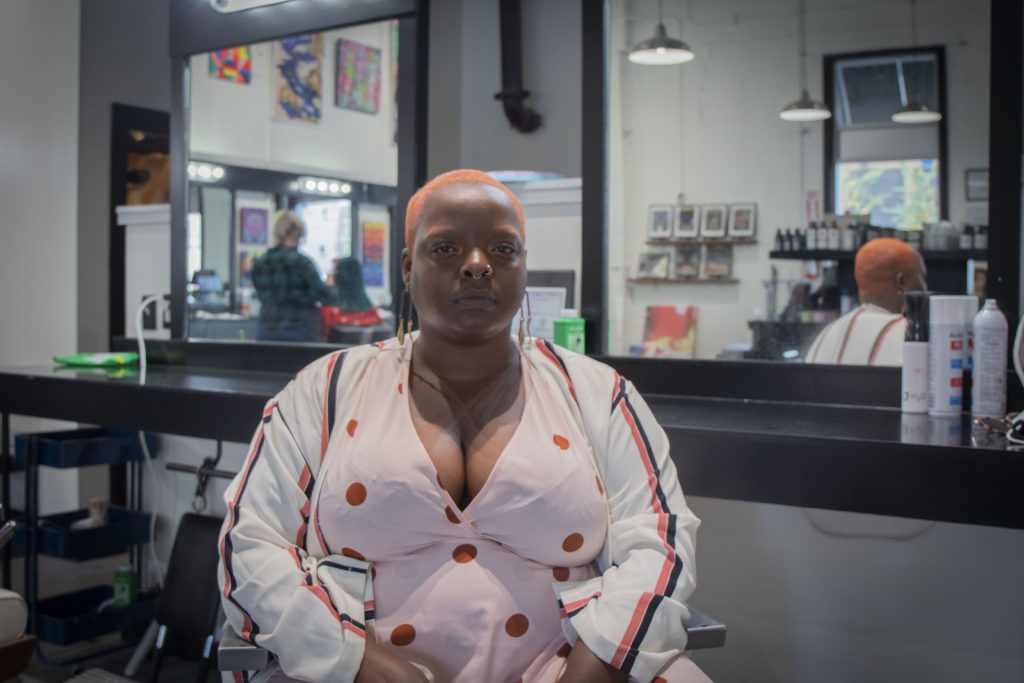
On special occasions as a child, Amber Curry recalls her grandmother transforming her hair into Shirley Temple curls that tightly hugged her head. She felt like a queen.
“It was church to a certain extent,” Curry says. “It was a time where my grandmother was pouring her energy and her strength into me by doing my hair. She was showing the versatility of Blackness.”
Now 36, Curry sports a fade in an effort to buck beauty standards that often define femininity with long, flowing hair.
Since slavery, beauty has represented power. White Europeans justified enslaving African people by deeming their curly hair and kinky texture as inferior.
“We talk a lot today about self-care in this very cheap way,” says Tiffany Gill, author of “Beauty Shop Politics,” and associate history professor at Rutgers University. “But for enslaved people, to care for one’s body became sort of an act of defiance. It became a way for them to assert their humanity and their dignity.”
She says wearing beautiful clothes and decorating their hair with bows was a way to assert their free identity and control over their bodies.
Washing out white supremacy
When Curry started working in Nashville’s entertainment industry and as a teacher at the Aveda Institute, she saw Black folks weren’t being welcomed like white clients. Administrators at her school encouraged her to focus on perfecting white hairstyling techniques, like cutting hair to add more texture and body. Black hair is less likely to need that, since it’s already textured.
“No one was really being a hairstylist, you know, taking their craft seriously. And being prepared for every person to sit in their chair,” she says. “They were really working within their comfort zone and they only wanted white folks to sit in my chair at the end of the day.”
She wants to shatter stereotypes of Black hair being “unruly” and “unprofessional” and elevate the craft of complexity that Black hair requires its experts to master.
This year, Curry created the Black Beauty School, where white and biracial stylists get schooled on terminology and what products are needed for a flawless twist out or wash-and-go.
In the six-hour class, stylists also learn how race and privilege contribute to hair discrimination in and out of the shop. So far, 25 people have completed the course.
But to master how to do Black hair takes practice and a commitment to education.
Black hair is more diverse, sensitive and can take more time to manage than white hair. While the foundation of shampooing, conditioning, detangling are similar, Black women tend to be more concerned with daily maintenance by wearing protective styles, wrapping their hair for bed and sleeping with silk sheets to protect their hair.
Worries about miseducation
Some beauticians have called out larger beauty schools for not going far enough to teach techniques for Black hair.
So that leaves white stylists like Brooke Julian, whose been doing hair for six years, struggling over the basics, like washing Black hair. White people are told not to wash their hair squeaky clean because it’ll strip the hair of natural oils. The opposite is taught for Black hair.
“I had no idea that you’re supposed to clean the hair enough to squeak. That’s genius,” she says. “I would have never thought to use that trick. Or, like, to watch the bubbles and watch what they’re doing, see how they react to different oils in their hair.”
WPLN News inquiries to the Aveda Institute and to Nashville’s Paul Mitchell school were not answered.
Julian now manages a team of stylists in Vancouver, Washington. Her staff and clientele largely reflect the whiteness of their city. While in Nashville, though, she attended the Black Beauty School. Her experience illustrates that cultural segregation persists outside the South.
“For me, I would just always say, like ‘Wow, they have like a ton of hair, like it’s really curly, it’s probably difficult to work with.’ Until I really got my hands into it,” she explains about her perception of Black hair prior to her schooling.
Julian and other non-Black stylists also heard directly from Black hair models who shared the ways race and privilege has surfaced in the salon chair.
Jazmin Ellis talked about her traumatizing experience getting a green hair dye and pixie cut by a white hairstylist at a Paul Mitchell salon.
“By the time I left the salon, my hair was at least green, but it was split,” she says. “Like crunchy. And just like not that soft kind of feeling that you get when you go to a salon. And your hair is like professionally done correctly.”
She describes her hair as an accessory that she loves to have fun with. But says she was stunned at the stylist’s lack of professionalism that led to her hair being damaged.
Schools and businesses have pushed some Black women to press out their kinks for straight hair, which they deem to be professional. It’s triggered Civil Rights lawsuits and pushed some cities and states to create legislation to protect Black women’s crowns.
Equity in service
Black women have made hair salons a safe space, catering to each other — from plates of comfort food down to the hair products. So, the Black Beauty School isn’t about erasing that experience. It’s to provide equity and more options.
Even Black Beauty School attendee Brooke Julian acknowledges her shop would need to make structural changes. Right now, its business model is centered around getting clients in and out of the chair as quickly as possible. That doesn’t allow the time and care Black hair can require.
“We don’t have time for that,” Julian says. “We do like 30-minute haircuts.”

